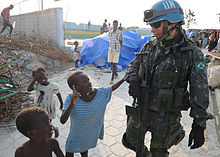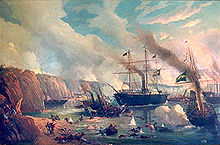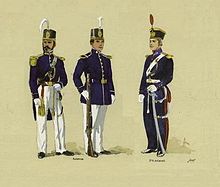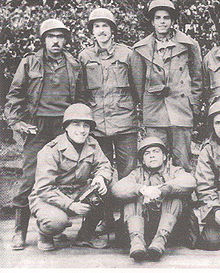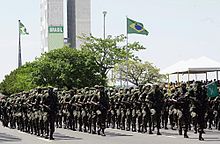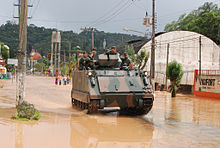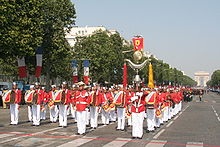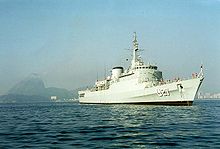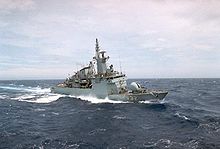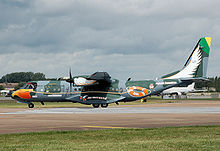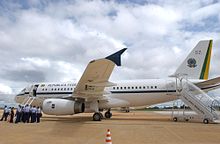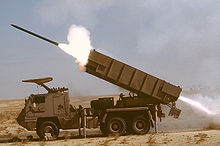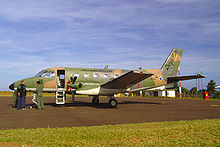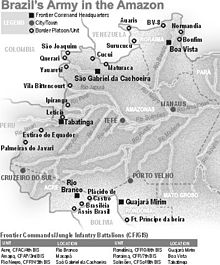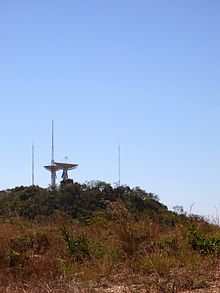- Brazilian Armed Forces
-
Brazilian Armed Forces
Forças Armadas Brasileiras
Parade of cadets of Academia Militar das Agulhas Negras in ceremony of the Marlins to new graduates.Service branches  Brazilian Air Force
Brazilian Air Force
 Brazilian Army
Brazilian Army
 Brazilian Navy
Brazilian NavyHeadquarters Ministry of Defense Leadership Commander-in-Chief President Dilma Rousseff Minister of Defense Celso Amorim Manpower Military age 18–45 years of age for compulsory military service Conscription 9 to 12 months Available for
military service53,350,703 males, age 16–49 (2010 est.),
53,433,918 females, age 16–49 (2010 est.)Fit for
military service38,993,989 males, age 16–49 (2010 est.),
44,841,661 females, age 16–49 (2010 est.)Reaching military
age annually1,733,168 males (2010 est.),
1,672,477 females (2010 est.)Active personnel 371,199[1] (ranked 13th) Reserve personnel 1,340,000 (2006) Expenditures Budget US$27.12 billion (2009)[2] (ranked 12th) Percent of GDP 1.5% (2008) Industry Domestic suppliers Embraer
Avibrás
Helibrás
IMBEL
Mectron
CBCForeign suppliers  United States
United States
 France
France
 Germany
Germany
 Italy
Italy
 Israel
Israel
 Russia
RussiaRelated articles History Military history of Brazil Ranks Military ranks of Brazil The Brazilian Armed Forces (Portuguese: Forças Armadas Brasileiras) is the unified military organization comprising the Brazilian Army (including the Brazilian Army Aviation), the Brazilian Navy (including the Brazilian Marine Corps and Brazilian Naval Aviation) and the Brazilian Air Force.[3]
Brazil's armed forces are the largest in Latin America, with 371,199 active-duty troops and officers. With no serious external or internal threats, the armed forces are searching for a new role. They are expanding their presence in the Amazon under the Northern Corridor (Calha Norte) program. In 1994 Brazilian troops joined United Nations (UN) peacekeeping forces in five countries. Brazilian soldiers have been in Haiti since 2004 leading the United Nations Stabilization Mission (MINUSTAH).[4]
The Brazilian military, especially the army, has become more involved in civic-action programs, education, health care, and constructing roads, bridges, and railroads across the nation. Although the 1988 constitution preserves the external and internal roles of the armed forces, it places the military under presidential authority. Thus, the new charter changed the manner in which the military could exercise its moderating power.[5]
Contents
Organization
The Armed Forces of Brazil are divided into 3 branches:[6]
The Military Police (state police) alongside the Military Firefighters Corps are described as an ancillary and reserve force of the Army.[6] All military branches are part of the Ministry of Defence.[7]
The Brazilian Navy which is the oldest of the Brazilian Armed Forces, includes the Brazilian Marine Corps and the Brazilian Naval Aviation. Brazil has the most powerful military of South America, and so are each of its military branches.[8]
Service obligation and manpower
21–45 years of age for compulsory military service; conscript service obligation - 9 to 12 months; 17–45 years of age for voluntary service. An increasing percentage of the ranks are "long-service" volunteer professionals; women were allowed to serve in the armed forces beginning in early 1980s when the Brazilian Army became the first army in South America to accept women into career ranks; women serve in Navy and Air Force only in Women's Reserve Corps.[9]
Mission and challenges
South America is a relatively peaceful continent in which wars are a rare event;[8] as a result, Brazil hasn't had its territory invaded since year 1865 during the War of the Triple Alliance.[10] Additionally, Brazil has no contested territorial disputes with any of its neighbours[11] and neither does it have bitter rivalries, like Chile and Bolivia have with each other.[12][13] However, Brazil is the only country besides China and Russia that has land borders with 10 or more nations. Moreover, Brazil has 16,880 kilometers (10,490 mi) of land borders[14] and 7,367 km (4,578 mi)[15] of coastline to be patrolled and defended. Overall, the Armed Forces have to defend 8.5 million km2 (around 3.2 million sq. mi.) of land and patrol 4.4 million km2 (around 1.7 million sq. mi.)[16] of territorial waters - or Blue Amazon, as the Brazilian Navy calls them.[17] In order to achieve this mission properly, significant quantities of both man power and funding have to be made available.
Military history of Brazil
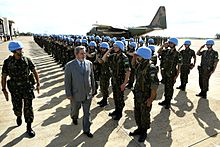 The former president Lula and Brazilian Army soldiers, part of the United Nations Stabilization Mission in Port-au-Prince, Haiti.
The former president Lula and Brazilian Army soldiers, part of the United Nations Stabilization Mission in Port-au-Prince, Haiti. Main article: Military history of BrazilSee also: Military of the Empire of Brazil
Main article: Military history of BrazilSee also: Military of the Empire of BrazilSince 1648 the Brazilian Armed Forces have been relied upon to fight in defense of Brazilian sovereignty and to suppress civil rebellions. The Brazilian military has also four times intervened militarily to overthrow the Brazilian government.[18]
It has built a tradition of participating in UN peacekeeping missions such as in Haiti and East Timor.[19] Below a list of some of the historical events in which the Brazilian Armed Forces took part:
- First Battle of Guararapes (1648): Decisive Brazilian victory that helped end Dutch occupation. Due to this battle, the year 1648 is considered as the year of the foundation of the Brazilian Army.[20]
- Brazilian War of Independence (1822–1824): Series of military campaigns that had as objective to cement Brazilian sovereignty and end Portuguese resistance.
- War of Cisplatina (1825–1828) : Armed conflict over an area known as Banda Oriental or "Eastern Shore" between the United Provinces of the Río de la Plata and Empire of Brazil in the aftermath of the United Provinces' emancipation from Spain.
- Platine War (1851–1852): The Brazilian Empire and its allies went to war against the dictator Juan Manuel de Rosas of the Argentine Confederation.
- Uruguayan War (1864–1865): Brazilian intervention in Uruguay. With support from Argentina, imperial forces deposed President Atanasio Aguirre from office and instated general Venancio Flores in his place.[21]
- War of the Triple Alliance (1864–1870): Also known as the Paraguayan War. Over 200,000 Brazilians fought on this conflict,[20] which is considered as the most serious in Brazilian history.[22]
- War of Canudos (1893–1897): The deadliest rebellion of Brazil, the insurrectionists defeated the first 3 military forces sent to quell the rebellion.[20]
- Brazil during World War I: Brazil entered into World War I in 1917 alongside with the Triple Entente. Brazil's effort in World War I occurred mainly in the Atlantic campaign, and a smaller participation in the land warfare.
- Brazil in World War II (1942–1945): Brazil declared war on Nazi Germany in August 1942[18] and in 1944 sent 25,334 soldiers to fight in Italy.
(Initially composed of an infantry division, eventually covering all Brazilian military forces who participated in the conflict. Including the Brazilian Air Force who did a remarkable job in less than nine months of war for Brazilians, with 445 missions executed. Offensive: 2546, Defensive: 4.)
.[23]
Brazilian military coup d'états
Although no military coups occurred during the 67 years of the Brazilian Empire, the Republican period experienced 4 military coup d'états in the 75 years between 1889 and 1964.
- Proclamation of the Republic (1889): End of the Brazilian Empire, this was the first coup d'état performed by the Brazilian military.[20]
- Revolution of 1930: Second military overthrow of government,[18] in which President Washington Luís was replaced by Getulio Vargas, who became the Provisional President.
- End of Estado Novo (1945): Then Dictator Getulio Vargas is deposed by generals and later General Eurico Dutra was elected president.[18]
- 1964 Brazilian coup d'état: President João Goulart is removed from office, leading to a military dictatorship which lasted until 1985.[18]
Ministry of Defense
Main article: Ministry of Defense (Brazil) Former Foreign Minister Celso Amorim and Armed Forces.
Former Foreign Minister Celso Amorim and Armed Forces.
Today, rare they are the countries that do not congregate its Armed Forces under an only agency of defense, subordinate to the Head of the Executive. In Brazil, until the year of 1999, the three Armed Forces were remained in independent ministries. However, the quarrel on the creation of a Ministry of the Defense, integrating the Navy, the Army and the Aeronautics is old. The Constitution of 1946 already cited the creation of an only Ministry, that resulted in the institution of the E.M.F.A, to the time called General staff. Ex-President of the Republic Castelo Branco, defended the thesis of the creation of a Ministry of the Defense. It signed Decree 200, of 25 February 1967, that the Ministry of the Armed Forces foresaw the promotion of studies to elaborate the law project creating. However, the proposal was abandoned. During the Constitutional conventional of 1988, the subject came back to the quarrel and one more time it was filed. Finally in 1992, President Fernando Henrique Cardoso, then candidate to the Presidency, declared that in its plan of government the quarrel for creation of the Ministry of Defense was foreseen.
The President of the Republic intended to still create the Ministry in the first mandate. The idea was to optimize the system of national defense, to legalize one politics of sustainable defense and to integrate the three Forces, rationalizing its activities. But only on 10 June 1999, the Ministry of the Defense was officially servant, the General staff of the Armed Forces extinct and the Aeronautics and Army, Navy department had been transformed into Commands. During the years of 1995/96 the EMFA, responsible for the studies on the Ministry of Defense, evidenced that, amongst 179 countries, only 23 did not have integrated Armed Forces. Of these 23, only three, amongst them Brazil, had dimensions politics to justify its creation, as for example, territorial extension and trained and structuralized Armed Forces. The Ministries of Defense of Germany, Argentina, Chile, Spain, USA, France, the United Kingdom, Italy and Portugal had been chosen for deepened analysis because they had some type of identification with Brazil, as territorial extension, population, cash of the Armed Forces, amongst others.
To give continuity to the creation studies, President Fernando Henrique created the Inter-ministerial Work group that defined the lines of direction for implantation of the Ministry of Defense. Reelected, he nominated senator Élcio Álvares, Extraordinary minister of the Defense, on 1 January 1999. The senator was the responsible one for the implementation of the agency. The three services are separate from each other, except in three areas: the Armed Forces General Staff (Estado-Maior das Forças Armadas-EMFA), the National Defense Council (Conselho de Defesa Nacional-CDN), and the Armed Forces High Command (Alto Comando das Forças Armadas-ACFA). The EMFA, which is involved in planning and coordination, interprets interservice views about policy and comes the closest to functioning as a ministry of defense. It is headed by a four-star general, and the chair rotates among the services. The ACFA is involved with more immediate, day-to-day problems. It is composed of the ministers of the three services, their chiefs of staff, and the EMFA chief.
According to Article 91 of the constitution, the CDN is "the consultative body of the president of the republic in matters related to national sovereignty and the defense of the democratic state." The members of the CDN are the president, the vice president, the president of the Chamber of Deputies, the president of the Senate, the minister of justice, military ministers, the minister of foreign affairs, and the minister of planning. The CDN has authority to "express an opinion in instances of declaration of war and the celebration of peace" and to "express an opinion on the decreeing of a state of emergency, state of siege, or federal intervention." In addition, the CDN is authorized to "propose the criteria and conditions for the use of areas that are vital to the security of the national territory and express an opinion on their continued use, especially in the strip along the borders, and on matters related to the conservation and exploitation of natural resources of any kind." The CDN also may "study, propose, and monitor the progress of initiatives necessary to guarantee national independence and the defense of the democratic state."
Interestingly, the highest level consultative body available to the president is the Council of the Republic (Conselho da República). This body does not include any military minister or officer, although the president may call on a military minister to participate if the matter is related to the respective ministry's agenda. According to Article 89 of the constitution, the Council of the Republic has authority to make declarations of federal intervention, a state of emergency, and a state of siege (all security-related issues).[24]
Brazilian Army
Main article: Brazilian ArmyArmy Cadets Preparatory School (EsPCEx) in Campinas, São Paulo.
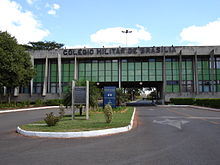 Military School of Brasília.
Military School of Brasília.
 Military Parade in Salvador, Bahia.
Military Parade in Salvador, Bahia.
 Leopard 1A1 Brazilian Army.
Leopard 1A1 Brazilian Army.
As in most South American nations, the Brazilian Army has been the most influential of the services because of its size, deployment, and historical development. Not only did senior army generals occupy the presidency from 1964 until 1985, but most of the officers who held cabinet posts during that time were from the army. In 1997 the army totaled 200,000 members. Brazil's army has strict up-or-out retirement rules, which were developed in the mid-1960s by President Castelo Branco. The internal command structure determines all promotions through the rank of colonel. The president is involved in the promotions to general and chooses one candidate from a list of three names presented to him by the High Command. Once passed over, the colonel must retire. All colonels must retire at age fifty-nine; and all four-star generals must retire at age sixty-six, or after 12 years as general.
Despite the up-or-out system, under President José Sarney the army became top-heavy as generals began to occupy many positions that previously had been reserved for colonels. In 1991 there were 15 four-star, forty three-star, and 110 two-star generals. The figure for four-star generals did not include four who were ministers in the Superior Military Court (Superior Tribunal Militar-STM). Thus, in the mid-1990s the army sought to reduce the number of active-duty generals. Considering the short conscript tour (usually nine to ten months), the army has a high number of conscripts: 125,000. Because of the need for literate and skilled young men to handle modern weapons, the army has served as a training ground for a large reserve force. Its highly professional officer corps serves as a nucleus around which the trained service would be mobilized if required.
The noncommissioned officer (NCO) corps is not well developed. NCOs have virtually no autonomy or authority. Emphasis on training and professional development is for officers only. The NCOs account for slightly more than one-third of the total army strength. About half of the NCOs are sergeants, who serve as command links between officers and ranks. Some also serve as middle-level technicians. In the early 1990s, the army began to undergo a generational change. The generals of the early 1990s had been junior officers in the early 1960s and had witnessed the military coup in 1964. Their worldview was shaped and influenced by the anticommunism of that time. These generals were being replaced by colonels who had entered the army in the early 1970s and whose view of the world had been shaped less by ideology and more by pragmatism. The United States, particularly through its counterinsurgency doctrines of the early 1960s, was more influential with the older group of officers.
The Army General Staff (Estado-Maior do Exército-EME) directs training and operations. The EME has expanded from four sections in 1968 to 15 sections in 1994. It is headed by the EME chief, except in the event of a war. From 1946 through 1985, the army was divided into four numbered armies: the First Army was centered in Rio de Janeiro, the Second Army in São Paulo, the Third Army in Porto Alegre, and the Fourth Army in Recife. Historically, the First Army was the most politically significant because of Rio de Janeiro's position as the nation's capital through the 1950s. The Third Army was also important because of its shared border with Argentina (Brazil's traditional rival in Latin America) and Uruguay. In 1964, for example, close to two-thirds of the Brazilian troops were in the Third Army, and somewhat fewer than one-third were in the First Army. The rest were sprinkled throughout the Second and Fourth Armies. The Planalto Military Command (Comando Militar do Planalto-CMP), comprising the Brazilian Federal District and Goiás State, and the Amazon Military Command (Comando Militar da Amazônia-CMA) supplemented the four armies.
On January 1, 1986, the army was restructured from four numbered armies and two military commands into seven military commands. The major addition was the Western Military Command (Comando Militar do Oeste-CMO), whose territory encompasses the states of Mato Grosso and Mato Grosso do Sul (previously under the Second Army territory), and Rondônia (previously under the CMA). Each of the seven military commands has its headquarters in a major city: Eastern Military Command (Comando Militar do Leste-CML), Rio de Janeiro; Southeastern Military Command (Comando Militar do Sudeste-CMSE), São Paulo; Southern Military Command (Comando Militar do Sul-CMS), Porto Alegre; Northeastern Military Command (Comando Militar do Nordeste-CMN), Recife; CMO, Campo Grande; CMP, Brasília; and CMA, Manaus. The CMP and CMO are led by major generals (three-star); the other five are headed by full generals (four-star). The army is divided further into 11 military regions. The CMSE is made up of only one state, São Paulo, and is in charge of protecting the industrial base of the country.
The changes were instituted as part of a modernisation campaign to make the army better prepared for rapid mobilisation. The reorganization reflected Brazil's geopolitical drive to "occupy the frontier" and the growing importance of Brasília, the Amazon, and western Brazil. In 1997 there were major units around Brasília, four jungle brigades, and five jungle battalions extending from Amapá to Mato Grosso do Sul. A tour with jungle units is a coveted assignment and is considered career-enhancing. The move to occupy the Amazon and the short-term political implications of the army's reorganisation should not be overstated. The army's geographic organization and distribution have continued to reflect a concern with internal rather than external defense. In what is perhaps an anachronism, the CML in Rio de Janeiro continues to have some of the best troop units and the most modern equipment. Command of the CML is still a coveted assignment, and the Military Village (Vila Militar), Rio de Janeiro's garrison or military community, is still considered one of the most important centers of military influence in the entire country. Principal army schools are located there or nearby. The CML is also important in countering the trafficking of drugs and armaments.
In a significant political development, the army established a formal High Command in 1964. Before that time, a clique of generals residing in Rio de Janeiro controlled major decisions of the army. Throughout the authoritarian period, tensions often existed between the High Command and the five generals who served as president. This tension was such that President Geisel dismissed Minister of Army Sylvio Frota in 1977. Since the January 1986 restructuring, the High Command has been composed of the seven regional commanders, the chief of staff, and the minister of army. The High Command meets to discuss all issues, including those of a political nature, and is responsible for drawing up the list of generals from which the president chooses those who will be promoted to four stars.[25]
Main article: Brazilian Navy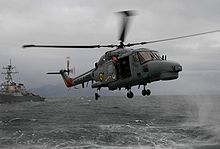 A Brazilian navy AH-11A Super Lynx Mk-21A helicopter prepares to drop a boarding team by fast rope during a visit, board, search and seizure (VBSS) exercise.
A Brazilian navy AH-11A Super Lynx Mk-21A helicopter prepares to drop a boarding team by fast rope during a visit, board, search and seizure (VBSS) exercise. Brazilian Inhaúma class corvette.
Brazilian Inhaúma class corvette.
The navy traces its heritage to Admiral Cochrane's mercenary fleet and to the tiny Portuguese ships and crews that protected the earliest coastal colonies from seaborne marauders. The navy is the most aristocratic and conservative of the services and draws a larger share of its officers from the upper middle class and upper class. Although it is involved in "brown-water" (riverine and coastal) operations, the navy's primary goal has been to become an effective "blue-water" navy, able to project power on the high seas. Given its "blue-water" bias, the navy is even less inclined to become involved in counterdrug operations than the army or air force.
The total naval strength of 64,700 in 1997 included Naval Aviation (Aviação Naval) with 1,300 members, the Marines (Corpo de Fuzileiros Navais-CFN) with 14,600 members, and only 2,000 conscripts. Naval operations are directed from the Ministry of Navy in Brasília through the Navy General Staff (Estado-Maior da Armada-EMA), six naval districts (five oceanic and one riverine), and two naval commands-Brasília Naval Command (Comando Naval de Brasília-CNB) and Manaus Naval Command (Comando Naval de Manaus-CNM).
The 1st Naval District is located at the country's main naval base in Rio de Janeiro; the 2nd Naval District is in Salvador; the 3rd Naval District is located in Natal; the 4th Naval District is located in Belém; and the 5th Naval District is located in Porto Alegre. The 6th Riverine District has its headquarters in Ladário, near Corumbá on the Paraguay River.
Until the 1980s, the flagship of the ocean-going navy was the aircraft carrier Minas Gerais (the ex-British HMS Vengeance), which has been in service since 1945. Purchased from Britain in 1956, the Minas Gerais was reconstructed in the Netherlands in 1960 and refitted extensively in Brazil in the late 1970s, and again in 1993. In 1994 Mário César Flores, a former minister of navy, declared in an interview that the navy would be hard-pressed to defend the Minas Gerais in a conflict.
While the Minas Gerais was not considered likely to be replaced until the next century, it was nonetheless decommissioned in 2001 following the purchase of the French aircraft carrier Foch. The Foch upon entering service with the Brazilian Navy, was renamed the São Paulo. It operates A-4KU. As of July 2002, the fate of the Minas Gerais was still unknown, with China having reportedly made a surprise bid for its purchase.
The navy's priority re-equipment plans for the 1990s included the receipt of new Inhaúma-class corvettes, the construction of Tupi-class submarines, the refurbishing of the Niterói-class frigates, the acquisition of nine new Super Lynx and up to six former United States Navy Sikorsky SH-3G/H Sea King helicopters, the construction of the conventional SNAC-1 submarine prototype, and the development of nuclear-propulsion technology. In addition, the navy contracted in late 1994 to acquire four Type 22 British Royal Navy frigates and three River-class minesweepers for delivery in the 1995-97 period.
After years of intense rivalry between the navy and the air force for the control of naval aviation, President Castelo Branco decreed in 1965 that only the air force would be allowed to operate fixed-wing aircraft and that the navy would be responsible for helicopters. According to many critics, such an unusual division of labor caused serious command and control problems. The complement of aircraft carried by the Minas Gerais included at one point six Grumman S-2E antisubmarine planes, in addition to several SH-3D Sea King helicopters and Aérospatiale Super Puma and HB-350 Esquilo helicopters.
In accordance with the Castelo Branco compromise, the S-2E aircraft were flown by air force pilots and the helicopters by navy pilots. A crew of the Minas Gerais with full air complement consisted of 1,300 officers and enlisted personnel. As of late 2002, the Navy had reportedly become responsible for flying all aircraft with the rivalry having subsided between the two branches of the armed forces.[26]
Brazilian Air Force
Main article: Brazilian Air Force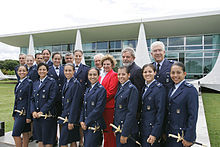 President Luiz Inácio Lula da Silva and first lady Marisa Letícia with the 2006 graduating class of female aviator cadets of the Brazilian Air Force on Alvorada Palace.
President Luiz Inácio Lula da Silva and first lady Marisa Letícia with the 2006 graduating class of female aviator cadets of the Brazilian Air Force on Alvorada Palace.
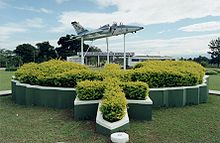 School of Aeronautics Expert in the city of Guaratinguetá.
School of Aeronautics Expert in the city of Guaratinguetá.
The Brazilian Air Force (FAB) is the biggest air force in South America. It operates more than 800 aircraft and has more than 50,000 personnel. The FAB is subdivided into four operational commands:
I FAE (I Força Aérea) Advanced fixed and rotary wings instruction; II FAE (II Força Aérea) Maritime patrol, SAR, helicopters transport roles and Navy support; III FAE (III Força Aérea) Fighter command, it has all first-line combat assets under its control - fighter, attack and reconnaissance aircraft; V FAE (V Força Aérea) - responsible for transport missions.
The Aeronautic Ministry was created on January 20, 1941, and absorbed the former Army and Navy aviation under its command. In 1944 the Brazilian Air Force joined Allied forces in Italy and operated there for about seven months, this was the FAB baptism in a real conflict. In 1999 after a creation of the Ministry of Defence (MoD), the Aeronautic Ministry changed its designation to Aeronautic Command, but no big changes happened to the air force structure, it kept almost the same organization it had before.
The biggest, and most important, program of the FAB in the last years is the SIPAM (Sistema de Proteção da Amazônia - Amazonian Protection System), the operational part of the SIPAM is known by SIVAM (Sistema de Vigilância da Amazônia - Amazon Vigilance System). The SIVAM is a huge network of radars, sensors and personnel integrated to guard and protect the Amazon Rainforest and its resources. In 2002 the Embraer R-99A AEW&C equipped with the Ericsson Erieye Airborne Radar and the R-99B SR (Electronic Intelligence Gathering version) entered service. The R-99 fleet is one of the principal components of the system, the aircraft are based at Anápolis AB near Brasília and fly 24 hours a day over the Amazonian region.
The backbone of the Brazilian combat aviation made up of three types, the Northrop F-5E/F, the Embraer/Aermacchi A-1A/B (AMX) and the Embraer A/T-29 Super Tucano. The F-5s are under a modernisation program called F-5BR program, the aircraft official designation is F-5M. The upgrade is being carried out by Embraer and Elbit; it includes a new avionics suite, a full glass cockpit with three MFDs, HOTAS configuration and a new multimode radar, the Italian Grifo F. The first F-5EM was handed over on September 21, 2005, and it is scheduled at a rate of two aircraft being delivered each month from that date onwards.
The A-1s are the main attack/ bomber aircraft of the FAB. There are three squadrons operating the A-1, one of them equipped with the RA-1 variant having a reconnaissance function as its primary role, but retaining all attack capabilities of the A-1. The RA-1s are equipped with RAFAEL's RecceLite reconnaissance system. Like the F-5, the A-1 is under a MLU (Mid Life Upgrade) program as well, this upgrade giving a high commonality between the avionics of the A-1M (MLU aircraft designation), the F-5M and the newly introduced Embraer A/T-29.
With the Mirage III withdrawn, the air defence of Brasília and region is done temporarily by a mix of F-5s from 1st GAv and 1st/14th GAv until 10 Mirage 2000Cs and two Mirage 2000B bought from French Air Force surplus stocks arrive at Anápolis. The Mirage 2000s are meant to be in service until at least 2015, when the Brazilian Air Force foresee the (postponed) F-X entering in service.
To replace the Embraer P-95 Bandeirulha in the maritime patrol duties, 12 Lockheed P-3A Orions have been bought from US Navy surplus and eight (with an option for a ninth) of them are being upgraded by EADS CASA in Spain, the remainder are to be used as spare parts source. On the same day of contract signature for the P-3BR work, 29 April 2005, EADS CASA was also awarded a contract to supply 12 C-295M medium transport aircraft. Deliveries started in 2006 with the first aircraft arriving in October 2006. The first three C-295s, designated C-105A Amazonas in Brazilian service, were commissioned into service in a formal ceremony at Base Aérea de Manaus on March 31, 2007. The C-105 replaces the FAB's C-115 Buffalo fleet and will supplement the C-130 Hercules.
The main heavy transport aircraft is the Lockheed C-130H Hercules and it will not change soon. The "Herks" are receiving major upgrades, receiving a full glass cockpit besides many other modifications. The first upgraded C-130 entering operational service recently. There are four Boeing KC-137 used as transport and tankers roles. In 2005 FAB received one Airbus ACJ, callsign "Air Force One" and dubbed as "Santos Dumont." The ACJ is now the main presidential transport and it is assisted by two Boeing 737-200 and one AS-332 Super Puma, with the KC-137 still serving as presidential transport in case of necessity. The basic pilot training is concentrated in Pirassununga (AFA - Academia da Força Aérea) and uses the Neiva T-25 and the well known Embraer T-27 Tucano for basic instruction. Advanced training is done at Natal AB in the AT-29 Super Tucano, which replaced the Embraer AT-26 Xavante in the conversion training course.
Military industry
A Brazilian-made Avibras ASTROS-II SS-30 multiple rocket systems on Tectran 6x6 AV-LMU trucks stand in firing position while being displayed as part of a demonstration of Saudi Arabian equipment during Operation Desert Shield in 1991.
Since the early 20th century, the armed forces have pursued the goal of weapons self-sufficiency. Their intention was never to develop a large arsenal but to have the technical capability to produce the arms needed for Brazil's military. During World War I, the large navy was cut off from resupply of big gun shells and became a paper navy, thus reinforcing the drive for self-sufficiency. The rapid industrialization that took place after 1930 provided the infrastructure necessary for developing an arms industry. After World War II, Brazil developed a steel mill at Volta Redonda, in Rio de Janeiro State, and quickly became the largest steel producer in Latin America. In 1954 Brazil began manufacturing its first automatic pistols. The earliest armored personnel carriers (APCs) produced by Brazil, in the 1960s, benefited directly from some of the technology developed by Brazil's dynamic automotive industry. Brazil's push for nationalization of the computer-related industry in the 1970s also began with the navy, which could not decipher the "black box" computerized range-finding and firing mechanisms on the British frigates they had purchased, and did not want to be dependent on imported maintenance.
In the 1950s, Brazil set up the precursor to the Aerospace Technical Center (Centro Técnico Aeroespacial-CTA). Located in São José dos Campos, the CTA became the focal point for the arms industry. The CTA has trained a generation of engineers through its technical institute, the Aeronautical Technology Institute (Instituto Tecnológico de Aeronáutica-ITA). In 1986 it was estimated that 60% of 800 Embraer engineers had graduated from the ITA. Brazil's three largest arms firms were established in the 1960s. Avibrás Aerospace Industry (Avibrás Indústria Aeroespacial S.A.-Avibrás) was established in 1961; Engesa, in 1963; and Embraer, in 1969. It was only in the subsequent period, from 1977 through 1988, that the three firms began to export arms on a large scale. In addition an estimated 350 firms are involved directly or indirectly in the arms production process in Brazil.
By 1980 Brazil had become a net exporter of arms. On the demand side, the rapid success resulted from a growing need in the developing world for armaments. On the supply side, Brazil's arms exports were designed for developing world markets and were noted for their high quality, easy maintenance, good performance in adverse conditions, and low cost. The product line was broad and came to include ammunition, grenades, mines, armored personnel vehicles, patrol boats, navy patrol planes, turboprop trainers, tanks, and subsonic jet fighters. In the early 1980s, Brazil emerged as one of the leading armaments exporters in the developing world. From 1985 to 1989, it was the 11th largest exporter of arms. Brazil exported arms to at least forty-two countries, in all regions of the world. By far the largest regional market was the Middle East, to which Brazil sold approximately 50% of its arms from 1977 through 1988. According to an estimate by the Stockholm International Peace Research Institute (SIPRI), 40% of all Brazilian arms transfers from 1985 to 1989 went to Iraq.
Brazil's arms industry nearly collapsed after 1988, as a result of the termination of the Iran-Iraq War (1980–88), a reduction in world demand for armaments, and the decline in state support for the industry. In early 1990, the two major manufacturers, Engesa and Avibrás, filed for bankruptcy. By late 1994, it appeared that Brazil's arms industry would not disappear completely. It was unlikely, however, that it would return to the robust form of the mid-1980s. Avibrás had paid off a substantial portion of its debt and was seeking ways to convert much of its production to civilian products. Engesa had been dismembered; some of its companies were sold to private interests, and its ordnance-related companies were taken over by the state and integrated with Imbel. Embraer was privatized in December 1994, and despite significant financial difficulties, it rolled out the new jet commuter plane prototype EMB-145 in 1995.[27]
Extensive modernization program
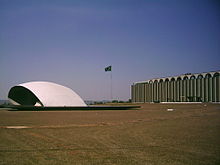 Brazilian Army headquarters in Brasília.
Brazilian Army headquarters in Brasília.
 Defense Minister Nelson Jobim and Commander of the Army Enzo Peri board a Brazilian Air Force plane headed to Haiti, to join assistance efforts in the aftermath of the earthquake there.
Defense Minister Nelson Jobim and Commander of the Army Enzo Peri board a Brazilian Air Force plane headed to Haiti, to join assistance efforts in the aftermath of the earthquake there.
In 2008 the Brazilian minister of defense has formulated the "Estratégia Nacional de Defesa" (National Defense Strategy), that claims to build a strong national industry and make strategic partnerships with allied nations to develop technology together.[28]
In 2008, Brazil has signed a strategic partnership with France and Russia to trade military technology. Brazil has also begun negotiations with France to have Brazil build 120 Rafale aircraft locally by Embraer.[29] Also in 2008 the Brazilian company Embraer showcased the Brazilian military transport aircraft, Embraer KC-390, and some countries already have shown interest in the aircraft, with France even placing orders.[30][31]
In 2009 Brazil purchased 4 Scorpène submarines for US$ 9.9 billion with a massive technology transfer agreement. In a second agreement, France will provide technical assistance to Brazil so that Brazil can design and produce indigenous nuclear powered submarines, to be completely built in Brazil.[32]
The Brazilian government has announced that a Helibras factory in the city of Itajubá, Minas Gerais, will initially produce 50 units of the EC 725 and up to 150 new helicopters for the Brazilian military. Helibras will now also produce Eurocopter's full line of products, with the first units to be operational in 2010.[33]
The Department of Defense of Brazil, in 2009 also asked the Brazilian Navy to develop a plan for the next 30 years. To carry out the plans of power projection that Brazil wants to run, the expenditure will cost more than US$ 138 billion, within the Navy alone. The program is called PEAMB.[34] The strategy is to buy or build 2 aircraft carriers (40,000 tonnes), 4 LHD (20,000 tonnes), 30 escort ships, 15 submarines, 5 nuclear submarines and 62 (patrol ships).[35]
In July 2009, the minister of defense, Nelson Jobim, said that Brazil will expend about 0.7% (US$ 13 billion) of the GDP per year to modernize the forces in addition to the 2.6% yearly defense budget. He stated, "We are raising a study to make the financial schedule of the entire project. It will be a 20 year plan, including modernization and expansion of the elements for defense of the Brazilian territory.[36]
Troop relocation
Brazil has the need to patrol its 16,880 kilometers (10,490 mi) of land borders.[14] Since the 1990s Brazil has been relocating its forces in accordance to this national security requirement.
Between 1992 and 2008, the 1st, 2nd and 16th Jungle Infantry Brigades,[37][38] the 3rd Infantry Battalion, the 19th Logistics Battalion, and the 22nd Army Police Platoon were transferred by the Army from the states of Rio de Janeiro and Rio Grande do Sul to the Amazon region.[39] in accordance with the friendship policy with Argentina. After those redeployments the number of Army troops in that region rose to 25,000.[40] Also relocated from the state of Rio de Janeiro were the 1st and 3rd Combat Cars Regiment, now stationed in the city of Santa Maria, in the state of Rio Grande do Sul.[39]
However, despite those efforts, the presence of the Armed Forces on the border regions of the Brazilian Amazon continues to be sparse and disperse, given the fact that the Army has just 28 border detachments in that area, a total of 1,600 soldiers, or 1 men for every 7 km (4.3 mi) of borders.[14] More redeployments are expected since the states of Rio de Janeiro, Minas Gerais and Espírito Santo still concentrate over 49,000 soldiers.[39] In May 2008, the Navy announced new plans to reposition its forces throughout Brazil.[39]
Earth observation
The Brazilian Amazon sustains about 40% of the world's remaining tropical rainforests and plays vital roles in maintaining biodiversity, regional hydrology and climate, and terrestrial carbon storage. Recent studies suggest that deforestation rates in the Brazilian Amazon could increase sharply in the future as a result of over US$ 40 billion in planned investments in highway paving and major new infrastructure projects in the region.
These studies have been challenged by several Brazilian ministries, which assert that recent improvements in environmental laws, enforcement and public attitudes have fundamentally reduced the threat posed to forests by such projects.
Among tropical nations, Brazil probably has the world's best monitoring of deforestation activity. Estimates are produced by Brazil's National Institute for Space Research (INPE) for the entire Brazilian Legal Amazon by visually interpreting satellite imagery from the Landsat Thematic Mapper. The relevance of the CBERS program does not limit itself only to applications of the satellite-generated images. The program also takes part in the Space Activities National Program (PNAE) which objective is to lead the country toward the autonomy of this technology so vital to our development.
The INPE participation in this complex project accelerates the capability of the country in important space technologies, besides contributing to increase and modernize the national industry in the space sector and the infrastructure (laboratories and centers) dedicated to space projects. There has been participation of the national industry in all satellite subsystems on charge of Brazil.[41]
See also
- National Force of Public Safety
- Brazil and weapons of mass destruction
- Policing in Brazil
- Military Police of Brazilian States
- Rondas Ostensivas Tobias de Aguiar: Military Police of the State of São Paulo.
- BOPE: Special Police Operations Battalion of the Military Police of the State of Rio de Janeiro, Brazil.
- Military Police of Rio de Janeiro State
- List of Wars involving Brazil
- Military of the Empire of Brazil
- Military Law
- Military Expression
External links
- Brazilian Ministry of Defence
- Brazil military profile from the CIA World Factbook
- Brazil military guide from GlobalSecurity.org
References
- ^ "Jornal da Globo - Veja as principais notícias do Brasil e do mundo no site do telejornal, com apresentação de William Waack e Cristiane Pelajo - NOTÍCIAS - Pesquisa mostra que Brasil investe pouco em estratégia na FAB". G1.globo.com. http://g1.globo.com/jornaldaglobo/0,,MUL1412734-16021,00-PESQUISA+MOSTRA+QUE+BRASIL+INVESTE+POUCO+EM+ESTRATEGIA+NA+FAB.html. Retrieved 2010-06-19.
- ^ The SIPRI Military Expenditure Database, SIPRI
- ^ According to article 144 of the 1988 Brazilian Constitution, the para-military Military Police alongside the Military Firefighters Corps are constitutionally considered an auxiliary and potential reserve to the Army, though subordinate to the state governors. They can, however, be compelled to federal service under a statute similar to posse comitatus[1].
- ^ Brazilian troops in Haiti
- ^ Information - Brazilian Army
- ^ a b "Brazilian Federal Constitution". Brazilian Government (official text). http://www.planalto.gov.br/ccivil_03/Constituicao/Constituiçao.htm. Retrieved 2007-05-17. See also: "Brazilian Federal Constitution in English", text translated to English (unofficial). Retrieved on 2007-05-17.
- ^ Ministry of Defence Structure "Defence" Ministério da Defesa. Retrieved June 22, 2007.
- ^ a b http://www.senado.gov.br/JORNAL/arquivos_jornal/arquivosPdf/080331.pdf (p. 9)
- ^ Military service age and obligation in Brazil
- ^ "Especial - NOTÍCIAS - Uma nova agenda militar". Revistaepoca.globo.com. http://revistaepoca.globo.com/Revista/Epoca/0,,EMI14439-15273-3,00-UMA+NOVA+AGENDA+MILITAR.html. Retrieved 2010-06-19.
- ^ https://www.cia.gov/library/publications/the-world-factbook/geos/br.html
- ^ "People's Daily Online - Bolivia bans Argentina from reselling gas to Chile". English.peopledaily.com.cn. 2006-10-25. http://english.peopledaily.com.cn/200610/25/eng20061025_315049.html. Retrieved 2010-06-19.
- ^ "Fresh anger over Bolivia gas plan". BBC News. April 16, 2004. http://news.bbc.co.uk/2/hi/americas/3632235.stm. Retrieved April 1, 2010.
- ^ a b c "Especial - NOTÍCIAS - Uma nova agenda militar". Revistaepoca.globo.com. http://revistaepoca.globo.com/Revista/Epoca/0,,EMI14439-15273-2,00-UMA+NOVA+AGENDA+MILITAR.html. Retrieved 2010-06-19.
- ^ "Litoral brasileiro - Geografia - UOL Educação". Educacao.uol.com.br. 2007-12-20. http://educacao.uol.com.br/geografia/litoral-brasileiro.jhtm. Retrieved 2010-06-19.
- ^ https://www.mar.mil.br/secirm/document/livrogeo.pdf (p.22)
- ^ https://www.mar.mil.br/menu_v/amazonia_azul/amazonia_azul.htm
- ^ a b c d e "Especial - NOTÍCIAS - Os pés de barro de um gigante". Revistaepoca.globo.com. http://revistaepoca.globo.com/Revista/Epoca/1,,EMI14440-15273,00.html. Retrieved 2010-06-19.
- ^ Rohter, Larry (August 1, 2004). "Brazil Is Leading a Largely South American Mission to Haiti". The New York Times. http://query.nytimes.com/gst/fullpage.html?res=9901E4DD1F3DF932A3575BC0A9629C8B63. Retrieved April 1, 2010.
- ^ a b c d "Especial - NOTÍCIAS - Uma nova agenda militar". Revistaepoca.globo.com. http://revistaepoca.globo.com/Revista/Epoca/0,,EMI14439-15273-4,00-UMA+NOVA+AGENDA+MILITAR.html. Retrieved 2010-06-19.
- ^ "História 2 Ano: 17 - Formação dos países platinos". Historia2ano.blogspot.com. 2008-11-17. http://historia2ano.blogspot.com/2008/11/17-formao-dos-pases-platinos.html. Retrieved 2010-06-19.
- ^ Arruda, José and Piletti, Nelson -Toda a História (1997)(7° edition)(229 p.)
- ^ Koshiba, Luiz and Pereira, Denise - História do Brasil (1999) (7° edition) (291 p.)
- ^ About Ministry of Defense of Brazil
- ^ Brazilian Army
- ^ Brazilian Navy
- ^ Military Industry in Brazil
- ^ https://www.defesa.gov.br/eventos_temporarios/2009/estrategia/
- ^ "Brazil to Buy 36 Rafales As France Extends Security Partnership". Defense-aerospace.com. 2009-09-08. http://www.defense-aerospace.com/article-view/feature/107881/brazil-to-buy-36-rafales-as-france-extends-security-partnership.html. Retrieved 2010-06-19.
- ^ [2]
- ^ notícias. "Brasil negocia com França compra de 36 jatos Rafale - MSN Notícias". Noticias.br.msn.com. http://noticias.br.msn.com/artigo.aspx?cp-documentid=21570434. Retrieved 2010-06-19.
- ^ "Novos submarinos da MB: Senado aprova o empréstimo de 4,32 bilhões de euros | Poder Naval". Naval.com.br. 2010-05-25. http://www.naval.com.br/blog/?p=17332. Retrieved 2010-06-19.
- ^ Farias, Ivy (September 8, 2008). "Brasil produzirá em Minas Gerais helicópteros para as Forças Armadas". Agência Brasil. http://www.agenciabrasil.gov.br/noticias/2008/09/08/materia.2008-09-08.2525261585/view. Retrieved on July 11, 2009.
- ^ https://www.mar.mil.br/peamb.html
- ^ "A nova geopolítica na América do Sul e o PEAMB | Poder Naval". Naval.com.br. 2009-09-13. http://www.naval.com.br/blog/?p=17940. Retrieved 2010-06-19.
- ^ "Folha Online - Brasil - Jobim questiona promessa francesa de transferência integral de tecnologia para caças - 08/10/2009". .folha.uol.com.br. 2010-01-17. http://www1.folha.uol.com.br/folha/brasil/ult96u635420.shtml. Retrieved 2010-06-19.
- ^ "Entrevista - Enzo Martins Peri". Resenha Eletr�nica. http://www.fazenda.gov.br/resenhaeletronica/MostraMateria.asp?page=&cod=372337. Retrieved 2010-06-19.
- ^ ":: Operação TIMBÓ IV ::". Fab.mil.br. http://www.fab.mil.br/portal/operacoes_aereas/solimoes/ft.htm. Retrieved 2010-06-19.
- ^ a b c d O DIA Online - União cortará tropa do Rio
- ^ "Estadão.com.br". 2008-04-20. http://www.estado.com.br/editorias/2008/04/20/pol-1.93.11.20080420.1.1.xml. Retrieved 2010-06-19.
- ^ Earth observation in Brazil
 Brazil
BrazilHistory First inhabitants · Colonization · Empire · Old Republic · Vargas Era · Second Republic · Military rule · ContemporaryGeography Regions · States · Mesoregions · Microregions · Municipalities · Islands · Coastline · Climate · Environment · Extreme points · Protected areas · CapitalsGovernment Constitution · Federal government · President · National Congress · Foreign relations · Law · Law enforcement · MilitaryPolitics Economy Society Demographics · People · Languages · Religion · Immigration · Education · Health · Crime · Social issues · Largest cities · ApartheidCulture  Category ·
Category ·  Portal ·
Portal ·  WikiProjectMilitary of Brazil
WikiProjectMilitary of BrazilHistory · Ranks · Marine Corps · Naval Aviation · Army Aviation · Ministry of Defence · Joint Staff of the Armed Forces · National Defense Council · Weapons of mass destruction
Militaries of South America Sovereign states Dependencies and
other territories- Aruba
- Bonaire
- Curaçao
- Falkland Islands
- French Guiana
- South Georgia and the South Sandwich Islands
Categories:- Military of Brazil
- Conscript militaries
Wikimedia Foundation. 2010.

